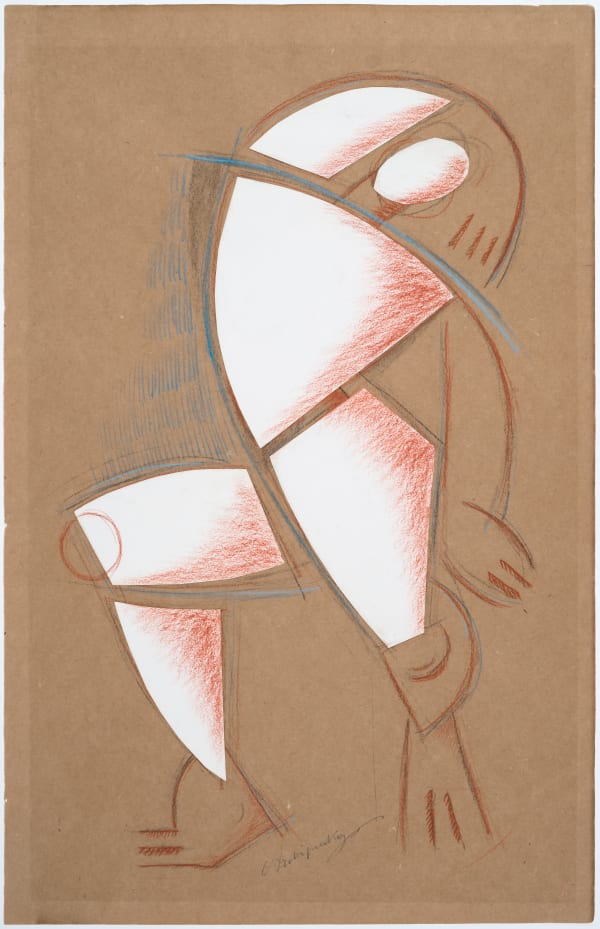Alexander Archipenko Ukraine, 1887-1964
-
 Figure, 1917 - 1921/1950s
Figure, 1917 - 1921/1950s -
 Title Unknown (Movement), circa 1913
Title Unknown (Movement), circa 1913 -
 Title Unknown (Dancing), circa 1914
Title Unknown (Dancing), circa 1914 -
 Walking Man, circa 1914 -1955
Walking Man, circa 1914 -1955 -
 Title Unknown (Walking), circa 1919
Title Unknown (Walking), circa 1919 -
 Draped Woman, conceived 1911/1957, cast 1968
Draped Woman, conceived 1911/1957, cast 1968 -
 Seated Figure, conceived 1913 - 1954, cast 1970
Seated Figure, conceived 1913 - 1954, cast 1970 -
 Boxers, conceived 1913/1914, cast 1964
Boxers, conceived 1913/1914, cast 1964 -
 Torso in Space, conceived 1935-1936/1946, aluminum cast 1958
Torso in Space, conceived 1935-1936/1946, aluminum cast 1958 -
 Form on Blue Background, executed in 1962
Form on Blue Background, executed in 1962 -
 Standing Woman and Still-life, painted in 1919
Standing Woman and Still-life, painted in 1919
Alexander Archipenko was born on May 30, 1887, in Kiev, Ukraine.
From 1902 to 1905 he studied painting and sculpture at the Kiev art school. In 1906 Archipenko moved to Moscow, where he participated in group exhibitions.
In 1909 he moved to Paris. He enrolled as a student at the École des Beaux Arts, which he left after a few weeks, as he found the program too academic. He completed his self-taught education in museums, including the Musée du Louvre. He moved into his studio in the Parisian Montmartre district and lived from 1909 to 1914 with other Russian emigrants, such as Vladimir Baranoff-Rossine, Sonia Delaunay-Terk and Nathan Altman, in the La Ruche artists' colony, where he meets Modigliani, Léger, Apollinaire, Cendrars, Gaudier-Brzeska and Raynal.
In about 1910, he was introduced to Cubism by Leger (whose studio was near his own) and he became one of the outstanding sculptors of the movement. In the same year he exhibited his works at the Salon des Indépendants with Cubists, including Delaunay, Duchamp, Duchamp-Villon, Le Fauconnier, Gleizes, Léger, Lhote and Metzinger. He also takes part in the Salons of 1911, 1912, 1913, 1914, and 1920. Frequents the Duchamp brothers’ salons, too.
Archipenko quickly built up a reputation in France and elsewhere, particularly in Germany. In 1912 he opened an art school in Paris and Boccioni, who arrived in Paris in 1911, visited Archipenko in his studio. The same year, he had a one-man exhibition at the Folkwang Museum in Hagen and in 1913 one at the Sturm Gallery in Berlin; also, in 1913 his work was included in the Armory Show in New York.
His rise to international prominence was interrupted by the First World War, during which he lived in Cimiez, a suburb of Nice; his work of this period included several sculpto-paintings, a type of work he created in which forms project from and develop a painted background.
After the war he soon relaunched his career, organizing an exhibition of his work that toured widely in Europe in 1919-21. In 1920 he participated in the XII Venice Biennale and the last cubist group exhibition at the Salon des Indépendants. An exhibition with the Section d'Or took him to Geneva, Brussels, Rome and (organized by Theo van Doesburg) to Rotterdam, Hague and Amsterdam.
In 1921 Archipenko moved to Berlin, married sculptor Angelica Schmitz (who worked under the name of Gela Forster) and resumed his artistic formation, then emigrated to the USA. He lived, worked, and taught in various places, but chiefly in New York, where he directed his own school of sculpture from 1939 until his death.
Alexander Archipenko died on February 25, 1964, in New York City












